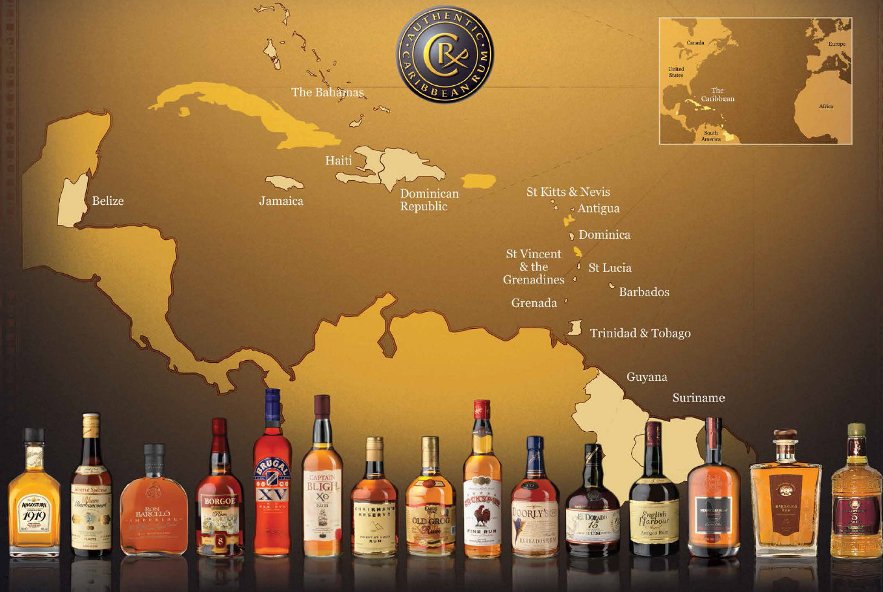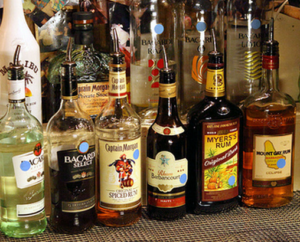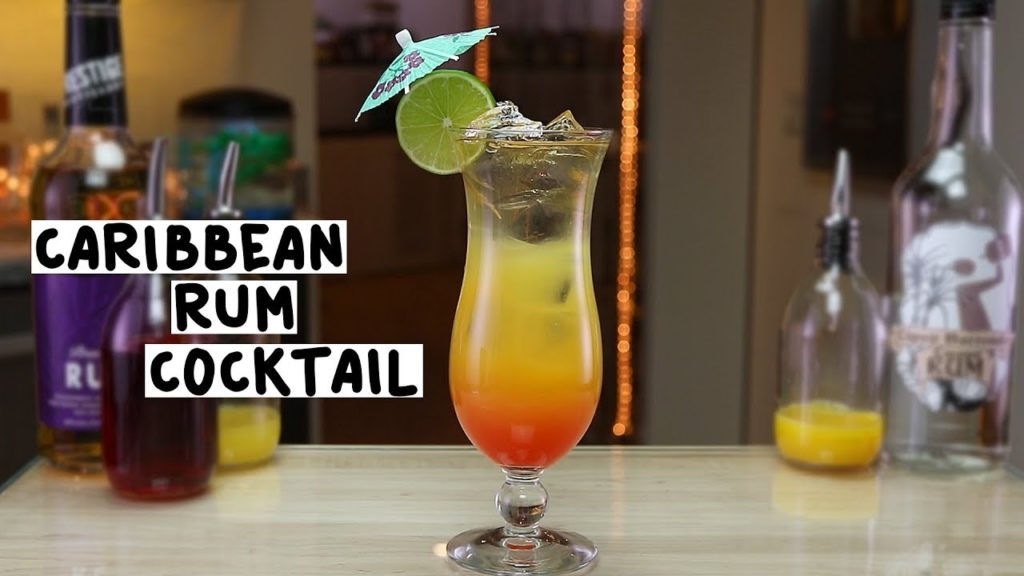 EL RON: EL SIEMPRE EMBRIAGANTE COGNAC DEL CARIBE.
EL RON: EL SIEMPRE EMBRIAGANTE COGNAC DEL CARIBE.
Para muchos alrededor del mundo la sola mencion de ‘El Caribe’ trae a la mente, diriamos de millones de personas.. Sol, Arena, Mar y.. Ron, una bebida ideal en todas las estaciones del año aunque principalmente para climas calientes por su refrescante y rico sabor que además se mezcla perfectamente con una verdadera variedad de frutas como mangos, guayabas o bananas sin esconder su destacada personalidad y aroma como sucede con el vodka que en su forma neutral tiende a esconderse en la creación de su mezcla.
Traido por Cristobal Colón en su segundo viaje a las Américas la caña de azúcar, cuyo jugo hervido deja una melaza que se fermenta y destila; éste es añejado por varios años y según donde descansa por años, mientras más mejor, así nos brinda un arcoiris de variedades y calidad. Cualquier versión del ron, sean claros u oscuros por lo regular tienen una graduación de alrededor de unos 80 grados. Su alto porcentaje de alcohol permite que al mezclarse consecuentemente con una variedad de otros componentes mantenga el exclusivo sabor que hace caracteristico al ron sin importar su versión.
La primera mención oficial conocida hasta ahora, donde se pronuncia la palabra Rum, aparece en una orden emitida por el Gobernador General de Jamaica en fechas tan lejanas como el 8 de julio de 1661. Otros estudiosos nos hacen llegar la información de que se menciona por primera vez en documentos provenientes de Barbados, en 1650, donde se le conoce por “Killdevil” o “Rumbullion”. En 1667 se le llamaba solamente Rum, de donde proviene la palabra españolizada Ron y la francesa Rhum.
El padre Jean Baptiste Labat, en una de sus observaciones plasmadas en crónicas dijo: “los salvajes, los negros y los pequeños pobladores de la isla, fabrican una bebida fuerte y brutal a partir del guarapo de la caña, que los alegraba y reponía de sus fatigas”.
UN BEBEDOR INCANSABLE, ERNEST HEMINGWAY.
Un “yanqui” corpulento y vestido con ropas anchas y estrujadas allá por los años 30s recorría diariamente desde su hospedaje en el Hotel “Ambos Mundos” de la Habana Vieja el rutinario camino que como escritor y amante de las bebidas fuertes terminaba en sus dos lugares preferidos (La Bodeguita y El Floridita). Allí Ernest Hemingway en lugar de Scotch, Bourbon o Whisky pedía un “brebaje” mezcla de jugos, azúcar y hojas aromáticas, sus tragos preferidos el Mojito y el Daiquirí con su bebida favorita, el Ron. Así transcurrió su vida por más de 20 años en pleno corazón de ese tesoro tropical que es El Caribe.
Para Hemingway y hoy todavía para muchos, un día feliz comienza con un ‘Mojito’ de doble porción de Ron (llamado en honor a Hemingway “Papa Doble”), jugo de limón, azúcar y hojas frescas de menta; para otros la “formula” toma el nombre de Daiquirí y une en un solo trago modelo jugos de lima, limón, azúcar de caña y ron blanco. Según los expertos el ‘Daiquirí’, una creación cubana, es uno de los más sencillas y perfectas creaciones jamás lograda.
Como en Cuba con el ron de la familía Bacardí hay otras muchas marcas de ron en el Caribe.
Bacardi, una de las empresas privadas de bebidas espirituosas más grandes del mundo fue conocida originalmente por su ron blanco Bacardi del mismo nombre. El emigrante espanol Facundo Bacardi le fundó en 1862, y es propiedad familiar durante siete generaciones, Bacardi fabrica en 29 instalaciones en 16 mercados en cuatro continentes. La compañía vende más de 200 millones de botellas por año. Bacardi Limited ha realizado numerosas adquisiciones para diversificarse de la marca homónima de ron Bacardi. En 1993, Bacardi se fusionó con Martini & Rossi, el productor italiano de vermut y espumosos Martini, creando el grupo Bacardi-Martini. En 1998, la compañía adquirió el whisky escocés Dewar, incluidas las ginebras Royal Brackla y Bombay Sapphire de Diageo por $2 mil millones. Bacardi adquirió la marca de tequila Cazadores en 2002 y en 2004 compró Gray Goose, un vodka de fabricación francesa, a Sidney Frank por $ 2 mil millones. En 2006, Bacardi Limited compró la marca de vodka de Nueva Zelanda 42 a continuación. A partir de enero de 2018, Bacardi Limited publicó planes para comprar el fabricante de tequila Patrón por $ 5.1 mil millones
Otro de los grandes productores de ron es Barbancourt, conocida por su larga tradición y el buen nombre de la familia Gardére, producido y embotellado en Haití por Société du Rhum Barbancourt. La compañía es una de las más antiguas de Haití, y su ron es una de las exportaciones más famosas del país. Dupré Barbancourt, un francés de la región productora de coñac de Charente, emigró a Haití. Después de aprender a hacer ron hacia 1863 destacandose con el tiempo por su refinado proceso de destilación y añejamiento en barriles de maderas de roble importados de la región francesa de Limousin semejante al Cognac de la colonial herencia francesa y que han dado al mercado uno de los productos mas reconocidos de la región.
Hoy hay muy buenos rones claros que se producen en Puerto Rico, República Dominicana, Guatemala, Nicaragua y Colombia, la producción de ron de las industrias de Barbados, Jamaica y Guyana se distinguen por su añejamiento y variedad.
Una encuesta hace unos años entre jovenes de 21 a 29 años llevada a cabo a través de 15 ciudades norteamericanas por las firmas ‘Invision’ y ‘Perception Research’ con sedes en Connecticut y Nueva Jersey evidencia, al preguntarsele a los jovenes sobre sus estilos de vida y habitos de bebidas, estos que “están bajo una fuerte tensión durante la jornada diaria de trabajo desean relajarse en locales de diversión nocturnos con bebidas alcoholicas”, según la encuesta publicada, los jovenes ven en la bebida algo que “les permite ser ellos mismos, auténticos, lo que libera su espiritu”.
El Ron, en el Caribe, se bebe de múltiples maneras: con cola, limón, gaseosa, con sumo de distintas frutas, con miel de abejas, con café, con agua natural y gaseada, agua de coco, hay quien lo mezcla con cerveza, zumo de tomate, se bebe en cientos de cócteles para incentivar el apetito o acelerar el proceso digestivo; sin embargo y paradójicamente a todas estas posibilidades de mezclar el ron, el caribeño, prefiere continuar bebiéndolo solo, e incluso, sin hielo, a pesar de un verano tan húmedo e intenso como el nuestro. Nada, idiosincrasia, cultura y tradición.
 THE RUM: THE EVER EMBRIAGANT COGNAC OF THE CARIBBEAN.
THE RUM: THE EVER EMBRIAGANT COGNAC OF THE CARIBBEAN.
For many around the world the mere mention of ‘The Caribbean’ brings to mind, we would say millions of people. Sun, Sand, Sea and .. Rum, an ideal drink in all seasons of the year although mainly for hot climates for its refreshing and rich flavor that also blends perfectly with a true variety of fruits such as mangoes, guavas or bananas without hiding its outstanding personality and aroma as with vodka, which in its neutral form tends to hide in the creation of its mixture.
Cane brought by Christopher Columbus on his second voyage to the Americas, whose boiled juice leaves a molasses that is fermented and distilled; This is aged for several years and depending on where it rests for years, the more the better, thus it gives us a rainbow of varieties and quality. Any version of rum, whether light or dark, usually has a graduation of around 80 degrees. Its high percentage of alcohol allows it to be consistently mixed with a variety of other components to maintain the exclusive flavor that makes rum distinctive regardless of its version.
The first official mention is known so far, where the word Rum is pronounced, appears in an order issued by the Governor-General of Jamaica as far back as July 8, 1661. Other scholars send us the information that it is mentioned by first time in documents from Barbados, in 1650, where he is known as “Killdevil” or “Rumbullion”. In 1667 it was called only Rum, where the Spanish word Ron comes from and the French word Rhum.
Father Jean Baptiste Labat, in one of his observations captured in chronicles, said: “The savages, the blacks and the small inhabitants of the island, make a strong and brutal drink out of the sugar cane juice, which made them happy and replenished. their fatigue “.
AN STRONG DRINKER, ERNEST HEMINGWAY.
A corpulent “Yankee” and dressed in wide, wrinkled clothes back in the 1930s traveled daily from his stay at the “Ambos Mundos” Hotel in Old Havana, the routine path that as a writer and lover of strong drinks ended in both places. preferred (La Bodeguita and El Floridita). There Ernest Hemingway instead of Scotch, Bourbon or Whiskey asked for a “concoction” mix of juices, sugar and aromatic leaves, his favorite drinks the Mojito and the Daiquiri with his favorite drink, the Rum. This is how his life for more than 20 years passed in the heart of that tropical treasure that is the Caribbean.
For Hemingway and today for many still, a happy day begins with a double portion ‘Mojito’ of Rum (named after Hemingway “Double Potato”), lemon juice, sugar, and fresh mint leaves; for others, the “formula” takes the name of Daiquirí and combines in a single model drink juices of lime, lemon, cane sugar, and white rum. According to experts, the ‘Daiquirí’, a Cuban creation, is one of the simplest and most perfect creations ever made.
As a very well known rum of the Bacardi family in Cuba, there are many other brands of rum in the Caribbean.
Bacardi, one of the world’s largest private spirits companies, was originally known for its Bacardi white rum of the same name. Founded in 1862 by the Spanish immigrant Facundo Bacardi, and family-owned for seven generations, Bacardi manufactures in 29 facilities in 16 markets on four continents. The company sells more than 200 million bottles per year. Bacardi Limited has made numerous acquisitions to diversify from the eponymous Bacardi rum brand. In 1993, Bacardi merged with Martini & Rossi, the Italian producer of vermouth and sparkling Martini, creating the Bacardi-Martini group. In 1998, the company acquired Dewar Scotch, including Royal Brackla and Bombay Sapphire gins from Diageo for $2 billion. Bacardi acquired the tequila brand Cazadores in 2002 and in 2004 bought Gray Goose, a French-made vodka, from Sidney Frank for $2 billion. In 2006, Bacardi Limited purchased the New Zealand brand of vodka 42 below. As of January 2018, Bacardi Limited published plans to buy tequila maker Patrón for $ 5.1 billion.
Another of the great rum producers is Barbancourt, known for its long tradition and the good name of the Gardére family, produced and bottled in Haiti by Société du Rhum Barbancourt. The company is one of the oldest in Haiti, and its rum is one of the country’s most famous exports. Dupré Barbancourt, a Frenchman from the Cognac-producing region of Charente, emigrated to Haiti. After learning to make rum around 1863, standing out overtime for its refined distillation and the aging process in oak barrels imported from the French Limousin region similar to the Cognac of the colonial French heritage and which have given the market one of the most recognized products of the region.
Today there are very good clear rums that are produced in Puerto Rico, the Dominican Republic, Guatemala, Nicaragua and Colombia, the production of rum from the industries of Barbados, Jamaica, and Guyana are distinguished by their aging and variety.
A survey a few years ago among youth ages 21-29 conducted across 15 North American cities by firms ‘Invision’ and ‘Perception Research’ with locations in Connecticut and New Jersey is evidence, asking youth about their styles of life and drinking habits, those who “are under strong stress during the daily workday want to relax in nightlife venues with alcoholic beverages”, according to the published survey, young people see in drink something that “allows them to be themselves, authentic, which frees their spirit. ”
Rum, in the Caribbean, is drunk in multiple ways: with cola, lemon, soda, with different fruits, with honey from bees, with coffee, with natural and carbonated water, coconut water, there are those who mix it with beer, tomato juice, is drunk in hundreds of cocktails to stimulate appetite or speed up the digestive process; however and paradoxically to all these possibilities of mixing the rum, the Caribbean, prefers to continue drinking it alone, and even without ice, despite a summer as humid and intense as ours. Nothing, idiosyncrasy, culture, and tradition.
Agencies/ Wiki/ ExcelenciasG/ Internet Photos/ Arnoldo Varona/ www.TheCubanHistory.com
THE CUBAN HISTORY, HOLLYWOOD.











